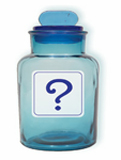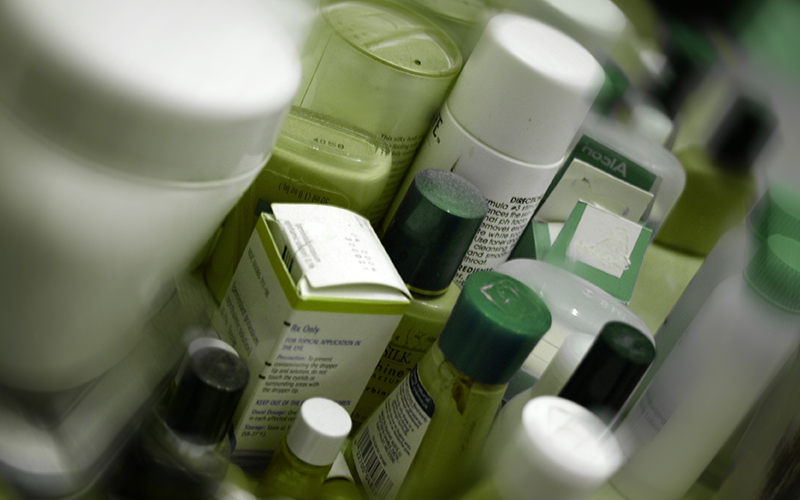One of the most common labeling errors is using type that is too small on your label. So how do you determine the right size of type? And what font size is that?
The right size of type is determined by the size of the container (not the size of the label itself), and the placement is determined by the size of type used.
Principal Display Panel
Every package, whether it is a bar of soap, a box, or a bottle has a “principal display panel” (referred to as the “PDP“). The Principal Display Panel is defined as the part of the package or label that the consumer sees or examines when the product is displayed for retail sale. Generally, it’s the top or the front of the package.
The principal display panel is an imaginary space; the actual label may be larger or smaller than the PDP. It is, however, the size of the PDP that determines the size of the text to be used.

Determining the PDP Size
The first step is to determine the PDP size, which is calculated based on the total size of the package. The PDP size is defined in “square inches,” which is a space 1 inch wide by 1 inch high.
Rectangular Container
For rectangular packages (such as boxes or bars of soap), the calculation is easy; the PDP is equal to the size of one entire side of the rectangle.
If a soap bar is 2 inches by 3 inches and 1 inch thick, then one entire side is 2 inches by 3 inches. To calculate the square inches, multiply 2 inches by 3 inches and you get 6 square inches, which is the size of your PDP.
Round or Cylindrical Container
For a round or cylindrical container (such as a bottle), the calculation is a little different; it’s 40% of the entire surface. To calculate, measure around the bottle (the circumference) and the height of the bottle, not including the slope at the top (called the “shoulder”). Multiply those two numbers, and you get the total of the entire surface of the bottle. Multiply that by 40% and you have the PDP.
If you have a 4 oz. cosmo bottle, the circumference is about 5.5 inches and the height about 3.5 inches. Multiply those two numbers and you get a total surface area of 19.25 square inches. Multiply that by 40%, and you have a PDP of 7.7 square inches.
Very Small Containers
For a small container that holds less than 1/4 ounce (by weight) or 1/8 oz. (by volume), which is labeled with a tag or an attached card, then the PDP can be calculated based on the size of the tag or card to which the product is attached.
Type Size
As noted, the type size is determined by the size of the PDP. Another factor in determining the type size is what information you are displaying.
Net Contents
For the Net Contents (which is placed on the front of your actual label within the imaginary outline of the PDP), the type size must be:
- PDP area less than 5 square inches: 1/16 inch type
- PDP area of 5 to 25 square inches: 1/8 inch type
Ingredient Declaration
For the ingredient declaration (which is placed on your actual label somewhere OTHER THAN the imaginary outline of the PDP), the type size is determined by the TOTAL space available for labeling (not just the PDP):
- Total labeling area of less than 12 square inches: 1/32 inch type
- Total labeling area of 12 square inches or more: 1/16 inch type
Which Font Size?
The size of the type is determined by:
- All upper case: size of upper case “L”
- Upper and lower case: size of lower case “o”
Since fonts are measured in “points” (not inches) and different fonts have different-sized letters, the font size required may differ based on the font you are using. Here are some examples:
All Upper Case
- 1/32 inch: Arial 3 pt, times 3 pt, Bodoni MT Condensed 4 pt
- 1/16 inch: Arial 6 pt, Times 6 pt, Bodoni Condensed 8.5 pt
- 1/8 inch: Arial 12 pt, Times 12 pt, Bodoni Condensed 14 pt
Lower and Upper Case
- 1/32 inch: Arial 5 pt, times 5 pt, Bodoni MT Condensed 6 pt
- 1/16 inch: Arial 9 pt, Times 10 pt, Bodoni Condensed 12 pt
- 1/8 inch: Arial 16 pt, Times 18 pt, Bodoni Condensed 20 pt
Additional Net Contents Requirements
When it comes to the Net Contents, there are a few additional requirements pertaining to the size of type to be used:
- The font needs to be bold.
- There must be a space the size of an upper case “N” both above and below the net contents, separating it from other text.
- There must be a space the size of 2 upper case “N’s” on either side of the net contents, separating it from other text.
- The letters themselves can’t be more than 3 times taller than they are wide.

Shameless plug!
To really be able to create your own labels that comply with the regulations, get my book from Amazon and use it.
4th Edition – Released March 5, 2025!!!
Or order directly from me (and get a signed copy)!


Leave a Reply